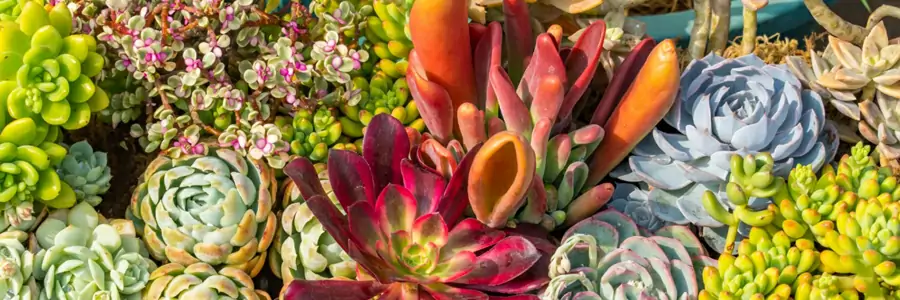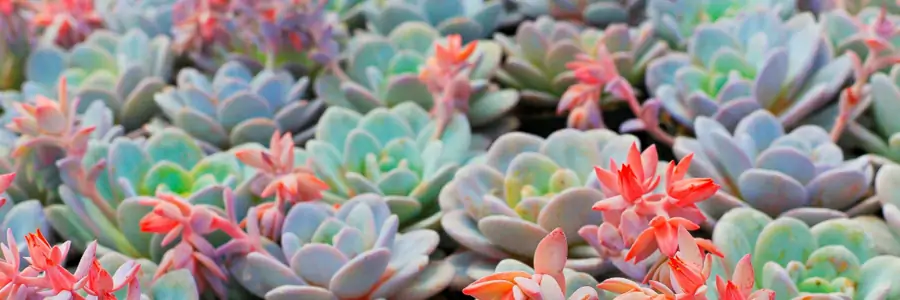Echeveria
Taxonomic Classification
Echeveria belongs to the family Crassulaceae. The Crassulaceae family is a large group of succulent plants, widely distributed around the world, especially in arid and semi – arid regions. Echeveria is one of the most well – known and diverse genera within this family, with over 150 recognized species. The genus was named in honor of Atanasio Echeverría y Godoy, a Mexican botanical illustrator who made significant contributions to the study of Mexican flora.
Morphological Characteristics
1.Rosette – shaped Growth
One of the most distinctive features of Echeveria is its rosette – shaped growth form. The leaves are arranged in a circular pattern around a central point, creating a compact and often symmetrical structure. The size of the rosettes can vary greatly among different species, ranging from a few centimeters in diameter for some miniature varieties to over 30 centimeters for larger species.
2.Leaf Features
The leaves of Echeveria are thick and fleshy, which is a characteristic adaptation of succulent plants to store water. They come in a wide variety of shapes, including rounded, lanceolate, and spatulate. The leaf margins can be smooth, serrated, or even ruffled in some species. The colors of Echeveria leaves are extremely diverse. Some species have leaves that are green, blue – green, or gray – green, while others display vibrant colors such as pink, red, purple, and orange. Many Echeveria species also have a powdery or waxy coating on their leaves, known as farina. This farina not only gives the plants an attractive, matte finish but also helps to protect them from excessive sunlight and reduce water loss through transpiration.
3.Flowering Characteristics
Echeverias produce flowers on long, erect stalks that emerge from the center of the rosette. The flowers are typically small, but they are often brightly colored and can be quite showy. The flower shape is usually bell – shaped or star – shaped, and they are arranged in clusters. The color of the flowers can range from white, yellow, and orange to red and pink. Flowering usually occurs in spring or summer, but the exact timing can vary depending on the species and growing conditions.

Common Varieties
1.Echeveria ‘Lola’
This popular cultivar is known for its compact rosettes and pastel – colored leaves. The leaves are a beautiful shade of pinkish – lavender, often with a slightly darker edge. ‘Lola’ is a relatively small – sized Echeveria, making it a great choice for small pots, terrariums, or as part of a mixed succulent arrangement.
2.Echeveria ‘Perle von Nürnberg’
One of the most well – known Echeveria varieties, ‘Perle von Nürnberg’ features rosettes of powdery, lavender – pink leaves. The leaves have a pointed tip and a slightly concave shape, giving the plant an elegant appearance. It can grow up to 6 – 8 inches in diameter and produces tall flower stalks with small, bell – shaped flowers in the spring and summer.
3.Echeveria ‘Black Prince’
‘Black Prince’ is a striking variety with dark, almost black – purple leaves that form tight rosettes. The edges of the leaves are often a bright red color, creating a beautiful contrast. It is a medium – sized Echeveria and can be a focal point in any succulent collection. ‘Black Prince’ also produces small, orange – red flowers on tall stalks during the flowering season.
4.Echeveria ‘Blue Atoll’
This variety has large, blue – green rosettes with a powdery coating. The leaves are broad and slightly curved, giving the plant a full and lush look. ‘Blue Atoll’ can grow up to 10 inches in diameter and is suitable for both indoor and outdoor gardens. In the right conditions, it will produce clusters of small, yellow – orange flowers.
5.Echeveria ‘Doris Taylor’
‘Doris Taylor’ is a unique Echeveria with ruffled, pink – hued leaves. The rosettes are relatively large and have a very distinct shape due to the ruffled edges of the leaves. This variety is a show – stopper in any succulent display and is sure to attract attention.

